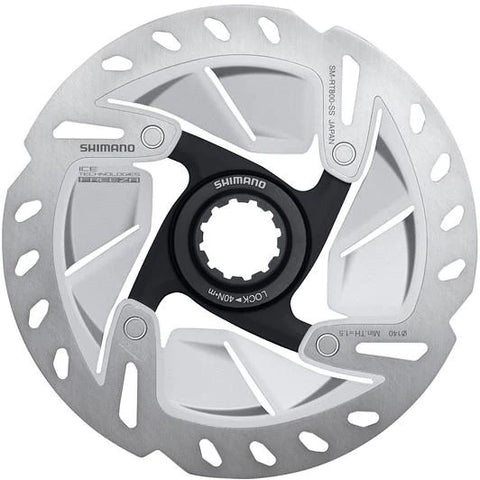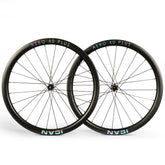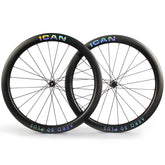6-bolt disc brake rotors vs. centerlock disc brake rotors
Many cyclists will find themselves in the situation of having to choose between 6 bolt rotors or centerlock rotors when building new bikes or just curious about braking performance for an upgrade.
How should we choose 6 bolt rotors and centerlock rotors which has no absolute answer. This depends on your needs and how much budget you are willing to bear.
The ICAN AERO Disc series is the most popular and lightest carbon rim we offer. You can choose between Center Lock and 6-Bolt. These wheels were assembled and centered by our experienced wheel builders. No settings are required. Simply take it out of the box, put the tires on and drive away.
It should be noted that the discussion of 6-bolt rotors and centerlock rotors is limited to disc wheels. If you use rim brake wheels, you don't have to worry about this situation.
In this article we will look at the difference between 6-bolt rotors and centerlock rotors from different angles so that in the end you know what suits you best.
Before the article, you can watch the video below to know the difference between them.
The main content of the article
- The history of brake discs
- Advantages and disadvantages of 6-bolt disc brakes
- Advantages and disadvantages of centerlock disc brakes
- Conclusion
The history of brake discs
Before disc brakes, there were drum brakes, which tended to brake overhead and lack performance. However, when racing cars were equipped with disc brakes in the 1950s, this new form of braking quickly spread to all types of vehicles. Back then, bicycle brakes worked on the same principle as disc brakes, with brake calipers pressing friction pads onto a rotating metal rim. The levers required strong hands to operate, and the fragile alloy wheels could heat up so much on a long downhill ride that the glue holding the tubular tires on them would melt.
Then in the 1990s came the disc brake revolution, in which the brake calipers were moved to hub height and met a rotating steel disc attached to the hub via a rotor. With the hydraulic disc brakes, a slight pressure on the levers was enough to lock the wheels. Mountain bike designers embraced disc brakes because they paved the way for long distances, thick tires, and greater freedom in frame geometry. The popularity of carbon fiber frames and wheels also pushed MTB brands towards new disc technology. Road racers were slow to follow their example. But it didn't last long.
The six-bolt rotor became the dominant standard in the MTB world, despite some design disadvantages.
Six screws hold the brake disc to the hub rotor; and the discs vary between 140mm - 220mm for a downhill mountain bike with extreme braking requirements. The screws are secured using a 6mm Torx wrench that must be tightened in a specific pattern to maintain accurate torque values. If the screw is tightened too tightly, it can break out; if it is too loose, it can fail while driving. New technology always brings new problems, and mechanics soon learned how to repair squeaky, warped, or misaligned windows. Installing a six-bolt rotor system is not a job for an inexperienced worker.
US Patent No.: US 6371252B1 was issued to Shimano on April 16, 2002, with the inventor named as Takanori Kanehisa. This patent related to the later Shimano Center Lock disc brake system. This invention made it possible to overcome most of the disadvantages of the six-screw system. The hubs were easy to assemble and maintain. The brake discs did not warp or become decentered. But Takanori's design only achieved these goals with a few compromises. It was heavier than the six-screw system and more expensive. The owner also had to invest in a special tool.
This is the Shimano TL-LR10. A torque wrench is used to mount the rotor to the hub, and also to lock the cassette in place. The inner part of the center lock rotor is made of a toothed alloy and fits onto the hub. This alloy helps dissipate the heat that builds up during prolonged braking. The outer part of the Shimano disc is made of durable steel that cannot warp. However, the Center Lock disc weighs 156 grams compared to the 115 grams of the six-bolt disc. With the TL-LR10, the entire assembly can be locked in the correct orientation in seconds. Decentering is not a problem and the job is done quickly, even by an amateur mechanic. Of interest to many riders are the Shimano Ice Tech Freeza rotors, which halve the 500° temperature of the disc on a long descent. With special pads, the disc can cool down to up to 300° and the brakes retain their bite right down to the valley.
There is one important thing to consider first with Centrelock or 6-bolt rotors. Both Centrelock and 6-bolt hubs and rotors work with your disc brake wheels. It doesn't matter what the brand or manufacturer of your disc brakes is. They work with both rotors.
The reason for this is that the terms 6 bolt or Centrelock refer to how you attach your rotor to your hub. As long as you have your rotor attached to the hub and it is properly centered, you will see that your brakes don't care and will still grab it and slow you down.

Two types of installation
The 6 bolts only require a 6mm Torx wrench, while the centerlock requires both a special tool and a 24mm open-end wrench.
The Centerlock special tool, known by the lock ring, is also used to remove the rear wheel cassette and is considered one of the essential maintenance tools for bikers.
Overall, the Centerlock can be installed and removed quickly compared to 6 screws, but appropriate tools are required.
Weight
We know that 6-bolt disc rotors are lighter, but since the center lock comes with its adapter, the comparison needs to be looked at from a different angle.
In comparison Shimano XT FH-M600 with SM-RT64 central locking and Sram 900 hubs combined with SM-RT56.
We found that the weight difference between the two hubs is more than 100 grams, so we can assume that the 6-bolt disc is lighter.
Price
For many reasons, such as higher production costs, the centerlock rotor is considered more expensive than the 6-screw rotor.
Since these models are manufactured by major brands such as Shimano and SRAM, they are expected to be more expensive than the 6-bolt rotors that can be manufactured anywhere else in the world.
Prices for 6-bolt rotors start at $10 (unknown or unbranded), while prices for Magura and Tektro vary between $20 and $25, while prices for top-level Shimano rotors range from $40 to $90 for a pair and prices for the top centerlock rotors range from $35 to $200.
Conversion from 6 bolts to central locking
Unlike converting from central locking to 6 deadbolts, which is considered easy and inexpensive, converting from 6 deadbolts to central locking is quite a challenge, but in the end it is possible.
From this we can briefly summarize the advantages and disadvantages of 6 latches and central locking.
Pros and Cons of 6 bolt disc rotors
|
Pros |
Cons |
|
Multiple rotor options |
Easily stripped when fitting |
|
Cheaper than Centerlock |
Can fail when riding |
|
Rotors are easily available |
You can accidentally fit them off center |
|
No special tools required. |
Easier to warp Less heat ventilation designHub treads get damaged under high torque. |
Advantages and disadvantages of centerlock disc rotors
|
Pros |
Cons |
|
Easy to center |
Less hub choice |
|
Rotors are harder to bend |
Heavy rotor |
|
Open for 6 bolts conversion Heat ventilation design. Fast installation and removal. |
It's a bit expensive Requires special tools |

Conclusion:
Six-bolt kits are available in any store anywhere in the world. But center lock parts are not so easy to source in a wide range, especially if you insist on sealed bearing hubs. If you want excellent design and comfort regardless of the cost, you should choose Center Lock. Even if you are the type of mechanic who is not obsessed with weight or relying on a wide range of parts.
You're better off with a six-bolt system if you're on a budget or have a mechanic with patience, gentle hands, and "bike likeability." Especially if you need a wide range of parts and sizes. And especially if you are a hill climber who gains a second for every gram you lose. If you have Center Lock and want to go back to the six-bolt system, Shimano offers an adapter: SM-RTAD05. But the opposite path is most likely impossible.





